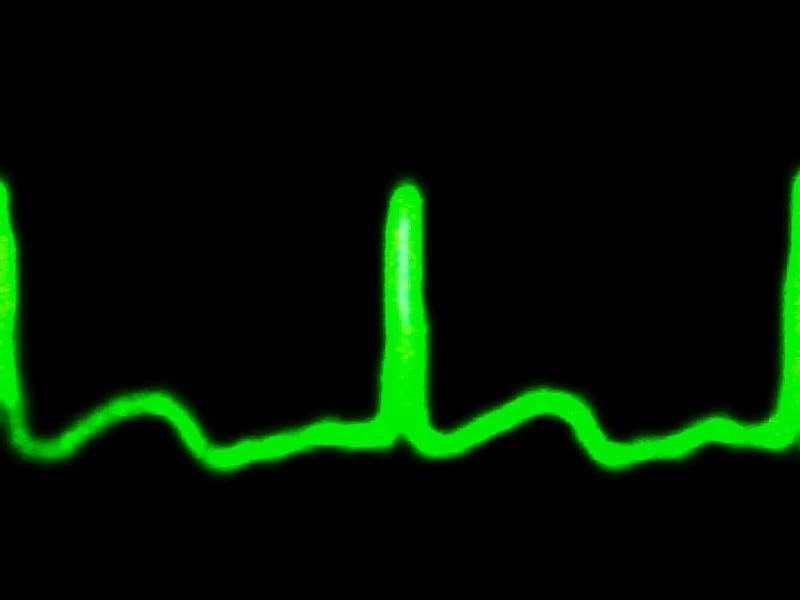Use an Apple Watch and Your Heart Rate to Answer the Big Question: Am I in Love?
Wearables track the changes in the body, whether it's working out or falling in lust.

It has become increasingly easy and increasingly desirable to quantify our track and clap along with our biological rhythms. As of 2014, there were 97,000 mobile health apps available, everything from downloadable trainers, to co-sleepers, to breath counters interfacing with everything from microchipped clothes to the Apple Watch. We use these tools to tell us about our lives, but most of the information they spit out is fundamentally trivial. Can they tell us something big? Can they tell us whether we’re in love?
There is no perfect way to detect love if you’re working with anything short of an MRI, but the Apple Watch is surprisingly effective in a pinch. Each watch has a custom sensor on the back, which uses visible light, infrared LEDs, and photodiodes to determine heart rate. Heart rate data is part of the available work out scheme the Apple Watch advertises but is also incorporated into a feature called Digital Touch. This seems ready made to connect couples: With a tap of the figure you can send a vibration to any contact also wearing an Apple Watch. Set two of your fingers down, and you can send them your heartbeat.
Imagine that you, with your Apple Watch, are on a date with another human with their Apple Watch. How do you find out if it’s time for love?
You can send your heartbeat with an Apple Watch.
The heart is both a literal and metaphorical representation of love. During the three stages of falling in love — lust, attraction, and attachment — the body releases various organic chemicals and hormones. This causes changes in the sympathetic nervous system, which in turn triggers changes in heart rate. Attraction, in short, causes the heart to race, a phenomenon Digital Touch can detect. What’s more interesting is that an Apple Watch could reveal deeper attachment as well: Studies have demonstrated that people in romantic relationships unconsciously co-regulate their physiologies.
A 2013 study from the University of California, Davis measured the heart rates of heterosexual couples who were asked to stare at each other for three minutes while being as calm as possible. They found that the women unknowingly adjusted their heart rates to match their partners’. Researchers couldn’t tell whether this was a psychological or physiological phenomenon, but they could absolutely tell it was happening. Still, mimicked heart rates could just be a law of nature. The theory of coupled oscillators says that when rhythms meet, they will coordinate. We can witness this when people fall into step, fireflies flash at the same time, and when heart beats match. Some research points to the idea that the closer you are with someone, the more likely your heart rate will sync.
Hearts can harmonize.
Your skin also can reveal your level of attraction to someone. Researchers use a test called the Galvanic Skin Response as an indicator of the people’s cognitive load and emotions. When a GSR measures a decline in the electrical resistance of skin to a current it can determine a measurement in arousal. The more attraction there is, the more the skin retains electrical currents because of the change in the sympathetic nervous system.
This is where Samsung comes in: Earlier this year the South Korean tech company announced it created a new chip that can measure body fat, skeletal muscle mass, heart rates, stress level, and skin temperature. The Samsung Bio-Processor allegedly is capable of determining Galvanic Skin Response, meaning you would be capable of determining how much you’re into someone. While a product utilizing this chip hasn’t officially been announced, Samsung has said that it could be utilized in a variety of ways, like usings wristbands and patches.
But for the impatient and for those who don’t want to cough up $549 for an Apple Watch, there is always the app Cardiio. Cardiio determines your heartbeat by analyzing the micro color changes in your face. When a heart beat quickens, it increases the blood volume, and when blood vessels expand, skin absorbs more light. So if you’re questioning if someone is really digging you — or if you’re feeling them — you could always upload a photo (taken immediately after interaction) and see if your heart rate has changed.
“I was I had this app while I was still dating,” said author John Havens during his TED talk. “I would have excused myself and I would have gone to the bathroom; I would have looked at the app, and I would have said — kind of like a Magic 8 Ball — ‘Hey Cardiio app, does this woman make my heart skip a beat?’”
Sure, the guy at the next urinal would be terrified, but Havens’ system still makes sense. Sometimes the answers to the most confusing questions are inside of us.